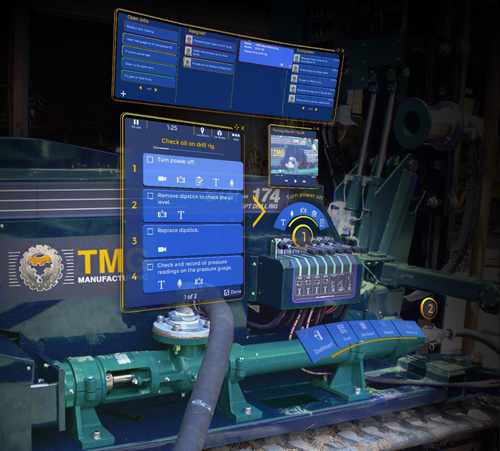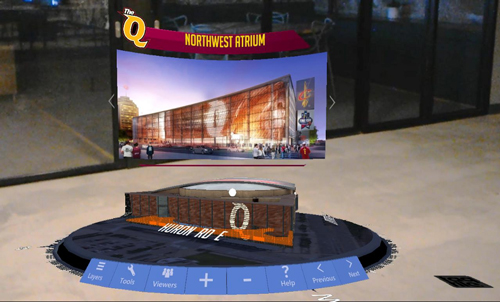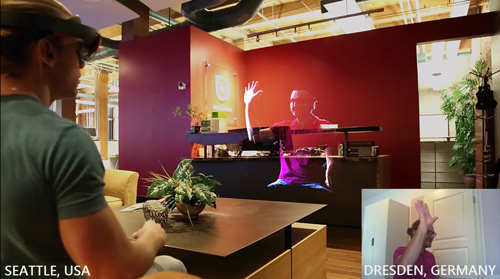In-Depth
How Microsoft Partners Are Building for the Future with HoloLens
Microsoft has taken some bold steps to democratize its mixed reality platform. Here's how some Microsoft partners are helping the company's efforts.
- By Gladys Rama
- June 05, 2017
It's been more than two years since Microsoft gave the first public demo of HoloLens at a media event in New York City that was ostensibly meant to showcase the forthcoming Windows 10 OS. On its own, the Windows 10 unveiling would have been news enough, its free-to-upgrade, continuously updating, "as a service" delivery model marking a sea change in Microsoft's approach to its flagship product. But the following introduction of HoloLens in the form of a surreal 15-minute demo spearheaded by Microsoft Kinect inventor Alex Kipman, who called it "the most advanced holographic computer the world has ever seen," added an unexpected degree of awe to the proceedings.
The demo showed how a person wearing the HoloLens headset and leveraging the built-in Windows 10 holographic capabilities could conceive, create and manipulate an object (in this case, a futuristic-looking drone) as if it were a 3-D object in real space. It also demonstrated the ability to interact with holographic renderings of other people who are physically located elsewhere (in this case, a miniaturized version of Terry Myerson, head of the Microsoft Windows and Devices Group). Considering the range of HoloLens customer stories that have come out since that January 2015 event -- it's since been used by NASA and the Jet Propulsion Lab, as well as more earth-bound organizations such as Volkswagen, thyssenkrupp and the National Football League -- that original demo now seems simultaneously fantastical and quaint. Over the past two years, Microsoft has amassed practical, real-world examples of HoloLens in action, helped by its efforts to make the technology more accessible to developers and partners. For instance, a developer edition is available for $3,000 and a commercial edition, which includes added security and device management features, is available for $5,000. There's an online Holographic Academy that walks beginners through the steps of developing for 3-D and holographic environments using HoloLens.
Microsoft also has a select roster of HoloLens Agency Readiness partners based in North America and Europe that have been specifically trained and certified to build HoloLens solutions. We talked to a few of these partners to get their thoughts on HoloLens -- how to begin monetizing it, what hurdles to be aware of and how they see the technology evolving in the future.
Where (and How) To Begin?
One big hurdle, arguably the foremost hurdle, is obvious: How do you start working with 3-D, mixed reality and hologram technologies if you don't already have a background in those specific fields? For many of Microsoft's HoloLens Agency Readiness partners, that question is moot. Many of them, such as Detroit, Mich.-based
Vectorform LLC, have built their businesses on cutting-edge Microsoft technologies that now serve as stepping stones to HoloLens.
Founded in 1999 and a Microsoft partner since 2001, Vectorform started out as a Web design and engineering company with a penchant for early technology adoption, says Woody Floyd, executive director of Vectorform's Seattle branch.
"Some of our early partnerships with Microsoft were on their large-format, multi-touch, multi-user platforms like Microsoft Surface," he says of the tabletop platform now known as PixelSense. The company was also an early adopter of the Kinect motion-sensing technology, which is at the core of Microsoft's Xbox development efforts, and has experience working with augmented and virtual reality platforms from other vendors -- for example, Google Glass. Given its background as an "invention company," Vectorform's decision to extend its portfolio to HoloLens seemed like a natural move.
"Our profile of having been a strong Microsoft partner and having all of that experience, it was a natural fit," Floyd says. "Our ability to have strong Unity developers, 3-D modelers, experience with motion, and with either augmented or virtual reality were definitely some key points."
Unity is a popular game development platform that's used to create 3-D games that can run on virtual reality platforms, in addition to more traditional consoles. Even though HoloLens isn't strictly a gaming platform, having expertise in Unity is a plus for HoloLens partners, given how graphics-oriented the technology is. For partners that are interested in HoloLens but don't have that kind of talent already built into their DNA, they might have to take a more acquisitive route.
That was part of the approach taken by Taqtile, a 6-year-old software and services company based in Seattle, Wash. Similar to Vectorform, Taqtile already had an established virtual reality background by the time it joined Microsoft's HoloLens partner program, having worked on platforms from Oculus, Google and HTC, among others. However, the company recognized that working with HoloLens would require building "a whole new muscle," says Co-Founder Dirck Schou. In 2015, the company "acqui-hired" Kihon Games, a small studio based in Tucson, Ariz., with whom Taqtile had previously worked and which had proven expertise in the ever-important Unity platform.
"When we had this opportunity [to become a Microsoft HoloLens partner], we said, 'Hey, we need a team. We know these guys. They know how to do Unity, which is one of the key things that you need to be able to do.' Most Microsoft partners, they don't even know what Unity is. So they have to get there somehow," Schou says.
He adds that Taqtile was uniquely prepared to work on HoloLens due to its prior work with Microsoft on Windows Phone Blue -- the code name for what would eventually become Windows Phone 8.1. "We weren't competing with every other company that was doing Office 365 activations. We were building mobile apps on Windows Phone. And that was a niche market. It did prepare us for working with another niche group within Microsoft," Schou says.
While having a strong background in Microsoft's emerging interactive technologies is a definite advantage, that doesn't mean that the path to HoloLens is barred against more traditional partners. Microsoft consulting partner Valorem was one of the first few HoloLens Agency partners that had roots as a traditional systems integrator, says Co-Founder and CEO Domnick Parretta. Founded in 2009, Valorem had built a solid portfolio around Microsoft Azure, Dynamics CRM and Office 365. However, as Parretta notes, Valorem may have had the cloud, engineering, development and architecture chops, but it lacked experience in 3-D. "We saw that as a big gap."
So Valorem took steps to fill that gap, taking advantage of Microsoft's Holographic Academy to train its existing employees on HoloLens and, like Taqtile, onboarding another company whose strengths could offset its weaknesses. In Valorem's case, that company was IdentityMine Inc., a software development firm that had a long history of developing interactive and immersive UXes built on technologies like Kinect and HoloLens (in fact, IdentityMine was already a HoloLens Agency partner by the time Valorem acquired it in mid-2016).
"That company had a place in the world where people are doing that type of work -- Unity, visual design, spatial audio and 3-D animation," Parretta says. "We said, look, we know it's going to take us too long to stay ahead of our peers if we just organically grow this, so we're going to make a strategic investment and pair up our capabilities."
Where the Opportunities Are
It's one thing to get your foot in the door of HoloLens as a certified partner or early adopter; it's another to actually incorporate it into your services portfolio and begin to monetize it. For a lot of partners, it can be a real challenge to identify the right target market for a product that many still consider to be experimental.
For Vectorform, the key was to create something that would have value and appeal in both the commercial and consumer markets. The company's HoloFramer app, which had its U.S. debut at the Microsoft Build conference in May, certainly fits that bill. HoloFramer uses HoloLens technology to let customers virtually decorate a wall in their home or office with any picture of their choosing, giving them a preview of the final look without hammering a single nail. For consumers, this "would ultimately help you with decorating a new home or doing a remodel," says Floyd. "But in the commercial space, [HoloFramer can act as] a tool for architects to preview what some of the interior space build-out could look like."
 [Click on image for larger view.] The HoloFramer app from Vectorform lets users holographically design the interior of their home or office.
[Click on image for larger view.] The HoloFramer app from Vectorform lets users holographically design the interior of their home or office.
Floyd says Vectorform is actively pursuing commercial users for HoloFramer, and the initial response has been very positive. He says the difficulty facing partners selling around HoloLens, particularly to the commercial market, is one that's common to most emerging technologies: "Because not everybody's used it or has seen it firsthand, it's not a platform you can sell as vaporware. You've really got to build up confidence that the platform is viable, that it can cover the needs that you're talking about and your team is able to support those needs."
Key to building that customer confidence is optics. This is especially important for something like HoloLens, which, for end users, is almost completely a visual experience. "Bring demos that your team has built [so] that they can actually experience your work firsthand," Floyd says. "To really nail something that is going to delight the person experiencing it, that's the key."
Taqtile's Schou echoes the importance of presentation when it comes to selling HoloLens-based solutions. "No. 1, you have to know how to demo. And, preferably, those demos are your own. It should be software that you've done. If you go out there and say, 'We're a HoloLens developer,' and you show the standard apps...that are on the [Microsoft Store], it's not enough."
What's also not enough, says Schou, is to throw HoloLens at any old customer problem just because it's a flashy solution, and not because it's the best solution. "Look for problems that can't be solved in any other way, or look for problems that can be solved in a quantifiably better way with HoloLens," he advises. "Determine whether something is a 2-D problem or a 3-D problem. Lots of things are 3-D problems. Lots of things are, you look at a screen and you figure it out. Do you really want to write letters or do document management in HoloLens? Maybe, I don't know, but probably not."
 [Click on image for larger view.] The Manifest app from Taqtile provides a virtual record of a field service agent's work.
[Click on image for larger view.] The Manifest app from Taqtile provides a virtual record of a field service agent's work.
Taqtile has a pair of HoloLens-based apps that are targeted at very specific use cases: a field inspection app called Manifest and a geographic visualization app called HoloMaps. Manifest, which Taqtile developed in close collaboration with Microsoft's Worldwide Public Sector group, enables service personnel to create a holographic record of the steps they took during a repair, giving other employees an educational resource to help with future repairs, as well as giving managers and inspectors a way to remotely audit field jobs.
"It's a real horizontal play," Schou says. "We have partnered with the [Microsoft] Public Sector because there are a lot of jobs in the government where you have to have an inspector go through and approve something, basically check things off. Say you're inspecting train tracks or critical infrastructure, bridges, that sort of thing."
 [Click on image for larger view.] Cleveland's Quicken Loans Arena is currently using Taqtile's HoloMaps app to manage its renovations.
[Click on image for larger view.] Cleveland's Quicken Loans Arena is currently using Taqtile's HoloMaps app to manage its renovations.
HoloMaps, meanwhile, lets multiple users collaborate over a holographic rendering of any geographic location or landmark. For instance, the Quicken Loans Arena in Cleveland, Ohio, is using HoloMaps to plan and present renovations to the site. "This allows you to look at a geographical location in three dimensions in a collaborative environment, move the map around [and] overlay data on top of that to better help you make decisions," Schou says.
These kinds of large-scale construction and engineering projects are certainly in line with much of Microsoft's promotional messaging around HoloLens. However, Valorem has also found a place for the technology in company meeting rooms, both large and small. Its HoloBeam app effectively adds a third dimension to today's telepresence and unified communications solutions by beaming in holographic images of meeting participants from different locations into a single meeting space.
 [Click on image for larger view.]
Valorem's HoloBeam app lets participants in different locations "meet" together using holographic technology.
[Click on image for larger view.]
Valorem's HoloBeam app lets participants in different locations "meet" together using holographic technology.
HoloBeam, which is just one of several HoloLens-based projects that Valorem is currently working on, is drawing a lot of interest from customers that aren't necessarily looking to solve industrial-scale problems, but are simply exploring ways to improve their day-to-day operations. "We've had a lot of interest from really big companies thinking about how they reduce travel costs, or bring people from one location together at others," Parretta says.
He adds that these kinds of opportunities for HoloLens anticipate a "culture change" in how people increasingly expect to do business. "I don't have to go travel to meet someone," he explains. "I can literally sit in my office, have cameras all around me and be there with other people, and see them on my screen and they can see me in 3-D. I think we're probably a couple of years away before companies start outfitting their rooms up front, but that's a different world once we get there."
What the Future Holds
It's likely true that widespread consumer embrace of the kinds of 3-D interactions that HoloLens makes possible is still some years away. At the same time, Microsoft is signaling that the traditional methods of communication and computing that it has championed for years are poised for a dramatic change. Look at its recent Windows 10 Creators Update release, for example, which comes with
built-in 3-D and hologram capabilities in the usually staid Paint and Office apps.
Nor are today's hardware form factors safe; Kipman, the Kinect inventor who also led the development for HoloLens, was quoted by Bloomberg last month as saying, "The phone is already dead. People just haven't realized." In the cloud-first, mobile-first and (maybe) post-phone world that Kipman seems to be predicting, there's plenty of room for exactly the types of bleeding-edge HoloLens solutions that Microsoft's partners are developing.
"I really see it as shifting paradigms in computing over time, and [being] a really big enterprise business opportunity as it matures," Parretta says, a sentiment echoed by Taqtile's Schou.
"What HoloLens really does is it drives a lot of services that Microsoft offers," Schou says. "It drives Azure, it drives integration with Dynamics, it drives AI, machine learning -- all these great initiatives that Microsoft has going on."
It's not without its challenges, and Schou cautions partners to do some serious soul-searching before embarking on HoloLens. "How is it going to fit in with all your other businesses?" he says. "If you're making business on Office 365 and Azure, there are models there. There's a margin you get as resellers, there are service contracts. What does HoloLens really get you unless you're continuing to drive those other components of your business? Does it just give you additional services revenue? Are you going to build software? If you're going to build software, how is that going to tie into these other resources that you want to sell and that Microsoft wants you to sell? It's complicated."
Beyond that, there's the fact that new technologies like HoloLens always tend to come up against a level of consumer resistance, which could tax a partner's commitment. "There's a degree of technology fatigue that HoloLens has to ride through, where it's coming at the same time as a lot of other platforms and on the heels of Google Glass," explains Vectorform's Floyd. "So the potential is strong. But how to make that leap into a larger scale of adoption, even within just the commercial space, will require a bit more time."
Nevertheless, odds are good that partner investment in HoloLens will eventually pay off. "We know that this space is going to matter," says Parretta. "It's going to, over time, change some of the areas of computing that we just take for granted today with keyboard and mouse."